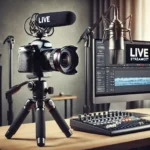Introduction
Choosing the right equipment & hardware for live streaming can significantly impact video quality and performance. One of the critical decisions you’ll face is selecting between HDMI and SDI (Serial Digital Interface). Both formats transmit high-definition video, but they cater to different use cases. Understanding their differences will help you make the best choice for your live streaming needs.
The Challenge: HDMI vs. SDI for Live Streaming
Many streamers struggle to decide between HDMI and SDI because both offer unique advantages. HDMI (High-Definition Multimedia Interface) is widely available and often found on consumer devices, while SDI is commonly used in professional broadcasting. If you’re working on a live stream setup, choosing the wrong connection type could result in poor video quality, signal loss, or unnecessary expenses.
Key Differences Between HDMI and SDI
| Feature | HDMI (High-Definition Multimedia Interface) | SDI (Serial Digital Interface) |
|---|---|---|
| Cable Length | Best for short distances (up to 50 feet) | Works for long distances (up to 300 feet) |
| Signal Type | Consumer-grade, uncompressed digital signal | Professional-grade, uncompressed digital signal |
| Connector Type | Standard HDMI, Mini HDMI, Micro HDMI | BNC connectors |
| Durability | Less durable connectors | Locking mechanism for secure connections |
| Cost | More affordable | More expensive but reliable |
| Common Uses | Gaming consoles, cameras, computers | Professional video production, live broadcasts |
Choosing the Right Equipment & Hardware for Your Needs
To determine whether HDMI or SDI is best for your live streaming setup, consider the following factors:
1. Distance of Your Cable Runs
- HDMI cables work best for setups where the camera is close to your streaming device (e.g., within 50 feet).
- SDI is the better choice for longer distances (up to 300 feet) without signal loss.
2. Durability and Reliability
- If you’re working in a controlled, indoor environment, HDMI may suffice.
- SDI cables have locking connectors, preventing accidental disconnections in professional settings.
3. Budget Considerations
- HDMI equipment is generally more affordable and widely available.
- SDI hardware is designed for high-end production environments, making it more expensive but sturdier.
4. Type of Streaming Setup
- HDMI is great for home studios, gaming, and webinars.
- SDI is ideal for multi-camera professional broadcasts, film production, and events.
Benefits of Using the Right Streaming Equipment
Selecting the appropriate video transmission format ensures:
- Better Video Quality – Professional-grade SDI ensures signal stability and clarity.
- Fewer Technical Issues – Avoids common problems like signal drops or poor connectivity.
- Scalability – SDI offers more flexibility for expanding your streaming setup with additional cameras or displays.
Conclusion
Both HDMI and SDI play essential roles in live streaming. The best choice depends on your specific needs, equipment, and budget. If you’re working on a short-distance, consumer-based setup, HDMI is sufficient. However, for professional, long-distance transmissions, SDI is the industry standard. Choose the option that aligns with your goals to ensure a smooth live streaming experience.
Looking for reliable streaming gear? Check out our recommendations for the best HDMI and SDI equipment for live production. Explore our gear list here.
